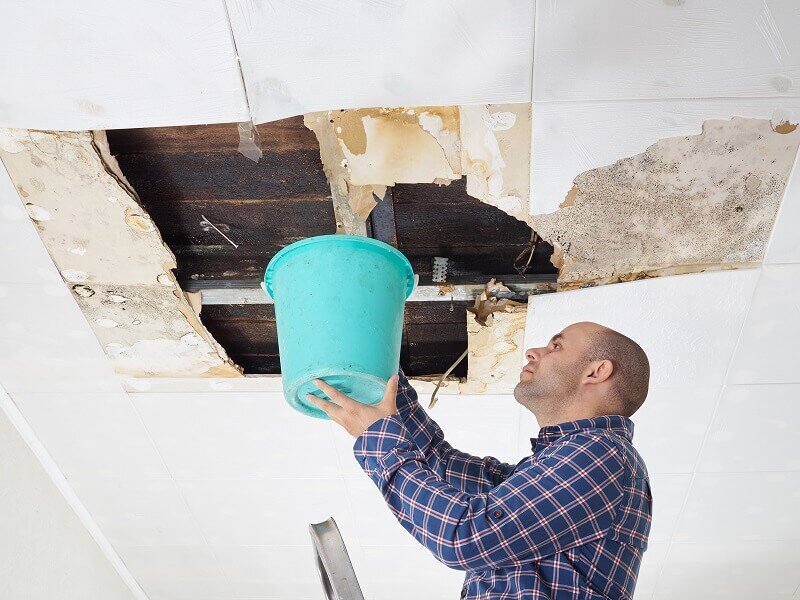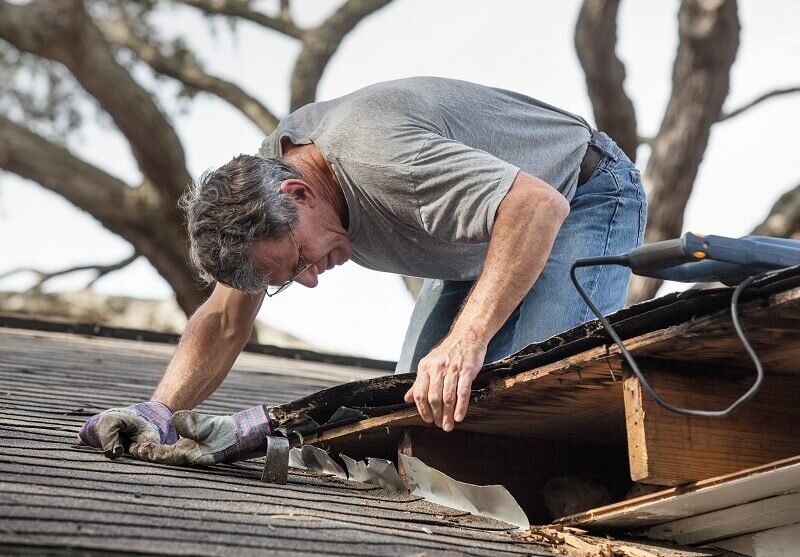
Without proper attention, water or moisture seeping into your attic can cause irreparable damage to the structural integrity of your roof. Damage will result in a gnarly roof leak. It is essential to be aware of the telltale signs that could indicate water damage caused by a range of factors, including the following:
- heavy rains
- HVAC system issues
- fissures and cracks in the walls, shingles, or your roof
- pest infestation
If you’re not careful, water leaks in your attic can lead to expensive repairs. From wet insulation to mold development, a moistened attic may cause structural damage and become hazardous to your family.
This guide will show you how to quickly and effectively identify, fix, and, most importantly, prevent attic water damage to restore your space to its former glory.
Identifying Attic Leaks
After every major storm that involves wind, rain, or hail – you should examine your roof and attic space and identify attic leaks. More sources of water damage include:
- Drain pans
- HVAC and lines
- Ice dams
- Burst pipes
Hidden water damage is a pain to find. Inspecting attic insulation close to potential sources of excessive moisture or areas where roof damage is likely can prevent and identify attic leaks in your home. Unfortunately, piles of insulation typically mask signs of water damage, so it’s essential to check thoroughly for any clues.
You’d like to identify attic leaks to mitigate water damage in your house. Preventing water damage in your home helps prevent mold and mildew growth. That’s important because mold poses a health hazard to your family.
Attic mold can induce severe illness; it’s essential to regularly assess for damaged areas and the potential presence of mold. This is especially crucial since attics often have high levels of moisture and heat that provide an ideal environment for active growth.
Finding Water Damage in an Attic
You’ll need to be vigilant to find water damage in the attic. To protect against potential water damage and consequential property losses, you must inspect vulnerable spots for buildup in:
- Air conditioners
- Chimneys
- Gutters
- Exhaust fans
- Rain guards
- Attic vents and roof vents
Check for Dampness
If a wall, attic flooring, or insulation is damp, that’s your first clue! Additionally, keep an eye out for moisture on windowsills and vents. Warm air and humidity could mean you have water intrusion. Last, be aware of musty odors, often due to mold caused by water damage.
Do an External Inspection
Checking your roof, gables, and gutters from the ground is an ideal way to detect any cracks, rotted wood, or clogged drains that may indicate attic water damage. If your roof inspection uncovers broken pieces of wood or a hanging gutter away from the house exterior, you may have a water damage attic.
Look for Discoloration
When inspecting the attic, check for discoloration or water stains in the ceiling materials. You can detect water damage by looking for dampness and signs of water seepage in the ceilings below your attic. If you notice any discoloration or moisture, inspect it further.
Checklist for Finding Water Damage in the Attic
Taking preventive measures through routine inspections and maintenance can help combat costly water damage. Here is a checklist to help you either prevent or identify water damage in your attic:
- Check and clean gutters and downspouts
- Check, repair, and seal chimneys, exhaust fans, and vents
- Trim trees that are encroaching on your roof
- Attic ventilation
Preventative maintenance is a must if you want to avoid water damage. A seemingly minor leak can quickly become a significant headache – yet with timely inspections and regular maintenance, it’s often possible to detect issues before they have time to cause serious trouble.

Fixing Water Damage in an Attic
There are a few key steps to fixing water damage in an attic. This is a guided list of steps you should take once you’ve identified a leak in your attic:
- Stop the leak
- Locate the source of the water
- Drain your ceiling
- Leak repair
Stop the leak
Water damage can be tricky – more extensive destruction is often not visible to the naked eye. So, it’s vital to act quickly and take steps toward preventing further damage by stopping the leak as soon as possible!
Locate the source
It can be challenging to pinpoint the exact origin of a leak. Water may come in at one place, but it’s only sometimes visible where the water is entering from – moisture seeping through walls or insulation and running down other areas of your ceiling could indicate an issue elsewhere.
To locate the origin of a leak, trail back along any dripping water and remember that it will always travel downward. Search for telltale clues like discolored walls, ceilings, and wet, mucky insulation to determine where the roof leakage comes from.
Drain your ceiling
If your ceiling under the attic leaks, it’s essential to address it quickly. Here are some steps to take when dealing with water damage:
- Cut off the power to the room with the ceiling problem by flipping its circuit breaker off.
- Move furniture away from the area under the ceiling stain or sag.
- Get something to contain the water, such as a bucket or bowl, and place it directly underneath the leak.
- Soak up any water on the floor using towels or a mop.
- Make a hole in the ceiling for drainage, and use a ladder to reach it safely.
- Once you’ve identified where the leak is coming from, you can begin repairs or contact a professional for water damage restoration if necessary.
- To prevent further damage, check for any other potential leaks in your home and repair them as soon as possible.
These steps can help minimize water damage and save you time and money on repairs!
Repair the leak
You can repair the leak by either a DIY project or by calling a professional. Usually, a repair requires a roofing contractor. Severe water damage will probably need a restoration company.
Selling a House With Water Damage in Attic
Selling a property with water damage can be tricky, regardless of whether the problem stems from a faulty pipe or a sudden intrusive flood. Unfortunately, these issues pop up after a home inspection.
Issues Selling a Home With Water Damage
Selling a property with water damage can be arduous for the seller, as it may result in numerous issues.
- If you decide to sell a home damaged by water, the sale price will probably be lower. You should also think about health risks.
- Living in or flooded home can cause problems such as mold growth, which could make you sick.
- Water damage affecting the home’s electrical system could lead to a security breach or even spark an electrical fire.
- If your property is near water or in a flood zone, destructive storms could cause future flooding.
Potential buyers may use this to haggle for a lower price.
Disclosing Water Damage in the Attic
Revealing any water damage to homebuyers is essential; failure to do so can lead to legal action. It’s also necessary for sellers to provide buyers with a disclosure document that outlines all known property issues.
Although disclosure regulations vary by state, it is better to be safe than sorry. If you do not mention any pre-existing damages regarding the property, then a buyer could take legal action against you after the sale. As this issue concerns health and safety, you may be liable in court if you were aware of water damage issues but failed to disclose them.
Selling Your House As-Is
If you’ve opted to sell your home with an attic leak, you may have a limited pool of buyers.
Obtaining a standard mortgage from the bank to purchase a leaky roof home is impossible due to the “habitability requirements” of banks and government agencies. Since these entities would deem it unsafe, they decline to lend for homes that require roof replacements.
That’s when you need a professional home buyer. You’ve seen the ads. They say, “Cash home buyers in Wisconsin” or “We buy houses Oshkosh.” Those professional cash buyers have the funds to handle their closing costs, meaning you don’t need to worry about whether they will qualify for a mortgage.
Working with a cash buyer can provide considerable benefits, namely, their ability to close quickly and purchase your property in its current state. You don’t have to fix anything or deal with restoration services. You can sell it as is. One huge benefit is that all sales proceeds directly go to the seller since no real estate agent commissions exist.
Selling your house fast is no difficult task. You can search for something like “sell a house fast in Milwaukee” to find a reputable company.
Nevertheless, being vigilant is of utmost importance when finding cash buyers. Not all are reliable; thus, properly vetting the buyer before making your selection is a must for guaranteeing that they are genuine experts.
Conclusion
Water damage in the attic can be a severe issue for homeowners. Selling a home with water damage can be challenging, as it can cause major structural problems and require costly repairs.
Selling a water-damaged house to a cash home buyer is often the best option, as they have the resources to take on the project and make necessary repairs. Cash home buyers can also close quickly, so you don’t have to worry about waiting for months while your house is on the market.
